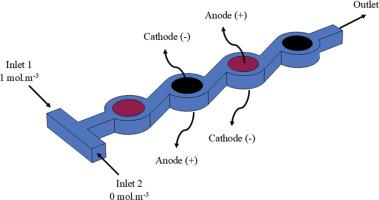具有圆形混合单元和收缩通道的电渗透微混合器的混合强化
IF 3.9
3区 工程技术
Q3 ENERGY & FUELS
Chemical Engineering and Processing - Process Intensification
Pub Date : 2025-09-15
DOI:10.1016/j.cep.2025.110557
引用次数: 0
摘要
本文对一种新型电渗透微流控装置中由微通道连接的圆形混合单元的混合增强机制进行了数值评价。通过直流(DC)电场下的三维模拟和交流(AC)电场下的二维模拟,分析了流场和微混合行为。直流电场结果表明,当进口速度小于0.1 m/s (Re = 10)时,增加电压可显著提高混合指数(MI);然而,在进口速度为0.5 m/s (Re = 50)时,MI基本保持不变。对于交流驱动的微混频器,随着Uin由0.05 × 10 - 3m /s增加到10 - 3m /s, MI得到改善。此外,MI随交流电压的增加而增加;然而,不同的频率会在MI中产生不同的趋势。高值的性能图(FoM),即MI与压降之比(Δp),证实了所提出的微混合器提供了出色的混合性能,特别是在低流入速度下。本文章由计算机程序翻译,如有差异,请以英文原文为准。

Mixing intensification of an electroosmotic micromixer with circular mixing units and constriction channels
This paper presents a numerical evaluation of the mixing enhancement mechanisms in a novel electroosmotic microfluidic device featuring circular mixing units connected by microchannels. Flow field and micromixing behavior are analyzed using three-dimensional simulations under a direct current (DC) electric field and two-dimensional simulations with an alternating current (AC) electric field. The results for the DC electric field indicate that when the inlet velocity (Uin) is below 0.1 m/s (Re = 10), increasing the voltage significantly improves the mixing index (MI); however, at an inlet velocity of 0.5 m/s (Re = 50), the MI remains largely unchanged. For the AC-driven micromixer, the MI improves as Uin rises from 0.05 × 10–3 m/s to 10–3 m/s. Additionally, the MI grows with increasing AC voltage; however, varying the frequency produces different trends in the MI. High values of the Figure-of-Merit (FoM), which is the ratio of MI to pressure drop (Δp), confirm that the proposed micromixer delivers excellent mixing performance, especially at low inflow velocities.
求助全文
通过发布文献求助,成功后即可免费获取论文全文。
去求助
来源期刊
CiteScore
7.80
自引率
9.30%
发文量
408
审稿时长
49 days
期刊介绍:
Chemical Engineering and Processing: Process Intensification is intended for practicing researchers in industry and academia, working in the field of Process Engineering and related to the subject of Process Intensification.Articles published in the Journal demonstrate how novel discoveries, developments and theories in the field of Process Engineering and in particular Process Intensification may be used for analysis and design of innovative equipment and processing methods with substantially improved sustainability, efficiency and environmental performance.

 求助内容:
求助内容: 应助结果提醒方式:
应助结果提醒方式:


